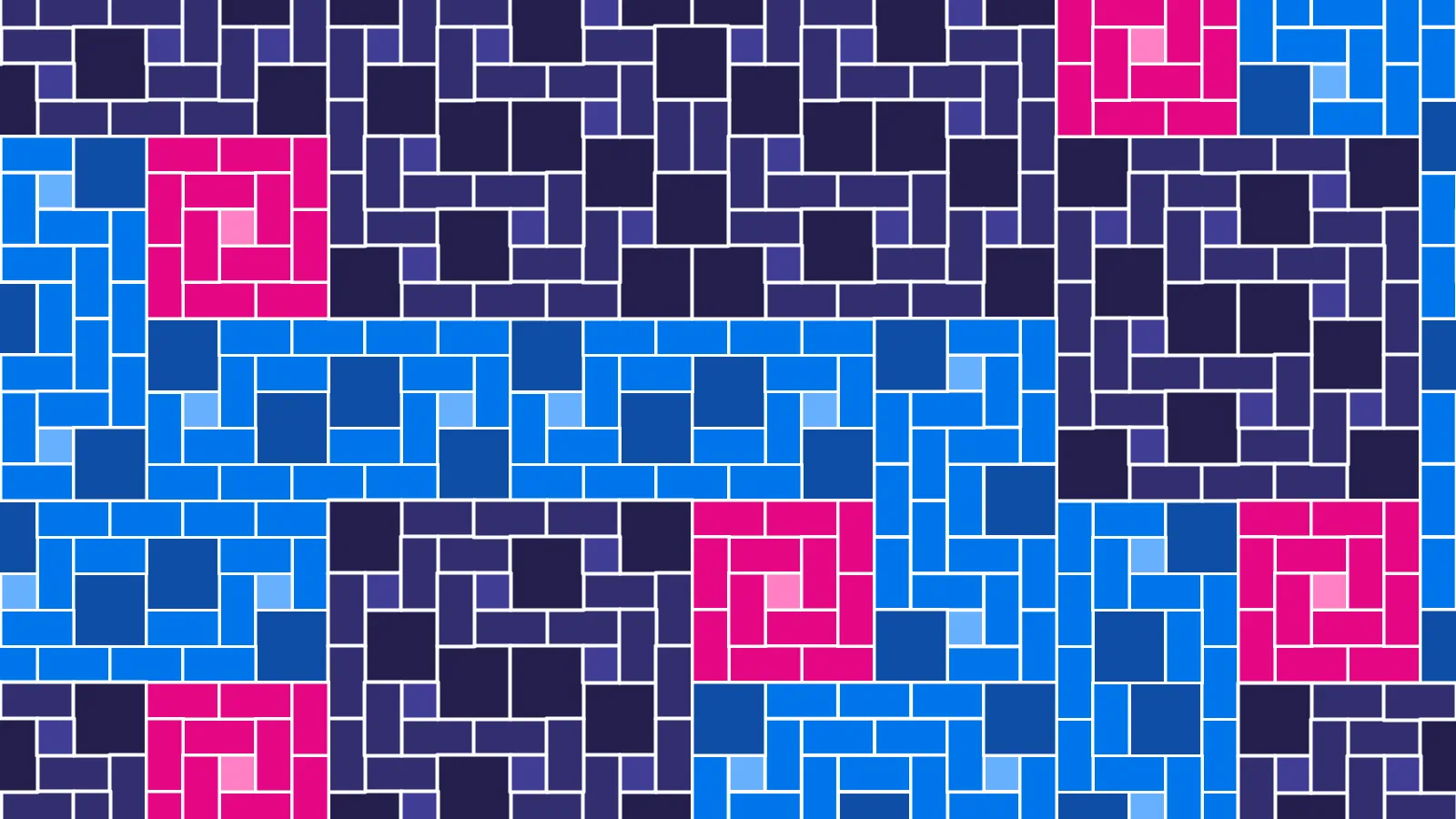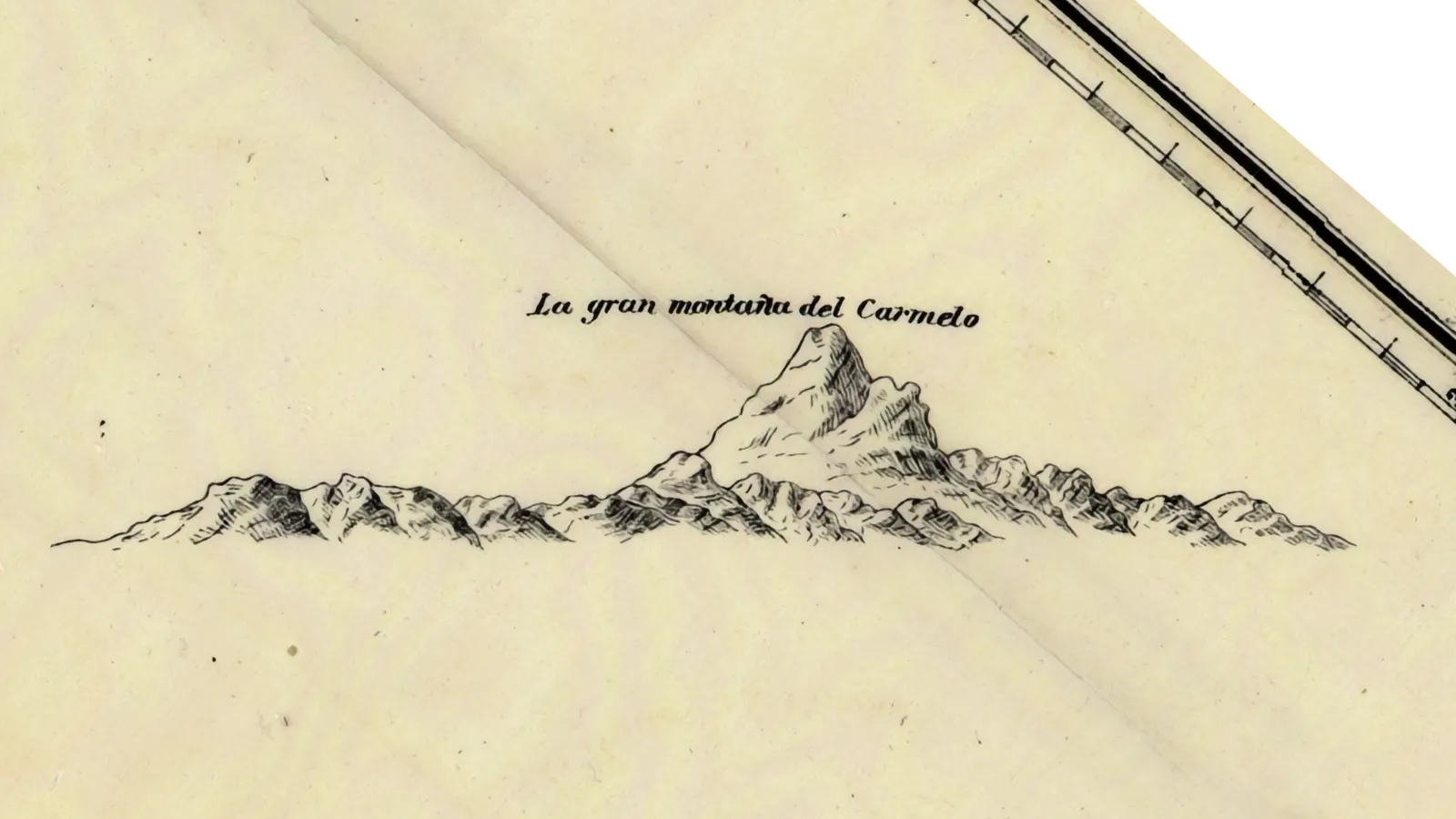
-

-

Brick pavements and tatami mats are traditionally laid out so that no four meet at a single point to form a ┼ shape. Only a few ┼-free patterns can be made using and tiles, but the addition of tiles provides a lot more creative flexibility.

Three ┼-free brickwork sections laid out in the stretcher bond, herringbone, and pinwheel patterns, respectively.
When I discussed tatami tilings with my relative Oliver Linton, he suggested applying similar rules to other brick sizes to make beautiful tiling patterns. The tatami condition alone does not provide enough of a constraint to mathematically analyze tilings with arbitrary shapes and sizes, but it is a good starting point when looking for interesting patterns.
With the addition of square tiles, it’s possible to construct rectangular blocks that fit together to tesselate the plane while preserving the four-corner rule.
Copies of the same rectangular block can cover the plane without four-corner intersections.
This opens the door to self-similar tilings, which I’m very interested in! The goal is to use , , and tiles to construct , , and blocks which can be put together in the exact same way to make increasingly intricate tilings that maintain the tatami condition.
The simplest non-trivial example I could find involves a set of , , and two rectangular tilings.
Four tilings of rectangles with the same aspect ratios as the bricks they comprise.
Starting with any of these four layouts, we can replace each of the , , and bricks with a corresponding , , or rectangular tiling in the correct orientation. (This will produce a few four-corner intersections, but we can fix these by merging adjacent pairs of bricks.)
The first recursive iteration of our tiling sequence.
Repeatedly performing this operation gives an infinite sequence of tilings, but can we say they converge to anything? A tiling can be identified with its outline (i.e. the set of points on boundaries between two or more tiles). Note that if a point is in , then it will be in every subsequent unless it is one of the few bricks merged in . So we might sensibly define the limiting object of the tiling sequence as the union
This self-similar dense path-connected set satisfies the topological equivalent of the “four corners rule” — a pretty interesting list of mathematical properties!
The same strategy could be applied to other sets of , , and tiles with similar boundaries. What’s the prettiest brickwork fractal you can find?
-

-
Although I’ve left academia, Bojan Mohar and I have published a new paper in the proceedings of SODA exploring the “perimeter” measure that plays a key role in my doctoral research. It is mostly based on Chapter 4 of my PhD thesis.
-

Mount Baker was named by George Vancouver after his third lieutenant, who was the first on his ship to see it.
Although the name is better than a few others in the Pacific Northwest, being the first person to see a giant mountain isn’t a particularly notable claim to fame. Especially when you have to ignore not only tens of thousands of people who lived there but also the Spaniards who had gotten there the year prior.
The mountain appears as la gran montaña del Carmelo on a map drawn by Gonzalo Lopez de Haro, first pilot on Manuel Quimper’s six-week expedition to the Juan de Fuca strait. The Spanish name is apparently a reference to a religious order whose white cloaks resembled the snow-capped peak. Who knows, if the Nootka Crisis had been resolved differently, it’s entirely possible that Europeans would have ended up calling it Monte Carmelo.
Instead, the name Mount Baker stuck after Vancouver described it in his published memoir.
About this time a very high conspicuous craggy mountain … presented itself, towering above the clouds: as low down as they allowed it to be visible it was covered with snow; and south of it, was a long ridge of very rugged snowy mountains, much less elevated, which seemed to stretch to a considerable distance … the high distant land formed, as already observed, like detached islands, amongst which the lofty mountain, discovered in the afternoon by the third lieutenant, and in compliment to him called by me Mount Baker, rose a very conspicuous object … apparently at a very remote distance.
Vancouver’s diary mentions encounters with different indigenous groups of the area, some friendly and some indifferent,1 but he never stuck around in the same place long enough to learn their names or pick up their languages.2 If he had, he might have recognized Mount Baker by the name kwelshan, the term used by the Lhaq’temish (Lummi) people around Bellingham and the San Juan Islands, or swáʔləx̣, reportedly used by the nəxʷsƛ̕áy̕əm̕ (Klallam) people on the Olympic Peninsula.
The mountain itself is surrounded by the traditional lands of the Nooksack and Upper Skagit peoples. The Nooksack use kwelshán for the high open slopes of the mountain and kweq’ smánit for the glacier-covered summit.
-
George Vancouver recorded people who “seemed to view us with the utmost indifference and unconcern… as if such vessels had been familiar to them, and unworthy of their attention”, which might have tipped him off that the Spanish had beaten him to the area. Instead, he wrote that he had “advanced further up this inlet than… any other person from the civilized world [sic]”.
-
Vancouver claimed that his crew had “some knowledge of” nuučaan̓uɫ from the Island’s west coast, but that’s from a different language family from the Salishan languages spoken around the strait.
-
-
😖 + 👻 = 🤧
-
At first they deployed a man with a stick. The groundsman approached one buzzing batch, decided his mode of attack would not work, and returned defeated.
Andrew Fidel Fernando / Cricinfo
on an ODI interrupted by bees -
I have succesfully defended my PhD thesis! It’s “packed” with results on graph immersions with parity restrictions, and “covers” odd edge-connectivity, totally odd clique immersions, and a new submodular measure that’s intimately connected with both.
I am grateful to NSERC for funding my degree with a Alexander Graham Bell Canada Graduate Scholarship, and to my supervisor Bojan Mohar.
-
If I could begin to be
Half of what you think of me
I could do about anything
I could even learn how to loveRebecca Sugar, “Love Like You”
-
US CONSTITUTION: No person except a natural born citizen shall be eligible for president.
MACDUFF: 😢
-
Urban planning oddities in Pokémon:
- Kanto Route 17: because a steep hill is the perfect place for a Cycling Road.
- Cave lighting and sliding block puzzles are an essential part of a transportation network.
- Hospital-adjacent land is considered prime real estate.
- Thirsty guards are a major source of traffic bottlenecks.
- A nonprofit society needing funding convinced Lavender Town council to rezone their memorial tower for radio use.
-
“May you live in interesting times” is typically claimed to be a Chinese expression, but it actually originated with the British. Joseph Chamberlain — Neville’s dad — used the phrase “interesting times” frequently in speeches:
I think that you will all agree that we are living in most interesting times. I never remember myself a time in which our history was so full, in which day by day brought us new objects of interest, and, let me say also, new objects for anxiety.
Joseph ChamberlainJoseph’s other son Austen was the first to claim it originated as a Chinese saying. Quote Investigator theorizes that Austen, in conversation with his diplomat colleagues, learned about a Chinese proverb that expresses apprehension about living in what his father would call “interesting times” and assumed that was the source of Joseph’s phrase. But the wording of the real proverb is entirely different:
Better to be a dog in days of peace, than a human in times of chaos.
-
Jens von Bergmann has run the numbers on land use in various municipalities in Metro Vancouver. The City of Vancouver in particular has lot of land tied up in streets and detached housing.
Use CoV land single-family detached houses and duplexes 34.0% roads and right-of-way 28.1% recreation, open space, and natural areas 15.2% commercial 3.9% low-rise apartments (residential or mixed-use) 4.1% high-rise apartments (residential or mixed-use) 1.9% Because the City of Vancouver has so little area left undeveloped, any proposals for new housing, schools, parks, stores, and so forth will displace some existing use of the land.
-

-

Preparing a presentation in LaTeX? Metropolis provides a simple, modern Beamer theme suitable for anyone to use.
Metropolis is available on CTAN and comes bundled with the latest TeX Live distribution.
I was a major contributor to Metropolis from 2015 to 2016. If you want to help make the theme better, you can join the development efforts on Matthias Vogelgesang’s GitHub page for the project.
-
I have a new paper, coauthored with my supervisor Bojan Mohar and colleague Hehui Wu and presented at the SIAM Symposium on Discrete Algorithms! It is my first foray into graph immersions with parity restrictions.
I am grateful to NSERC for supporting this research through an Alexander Graham Bell Canada Graduate Scholarship.
-
The word pea was originally pease in the singular and peasen in the plural. Eventually, speakers understandably interpreted the -s in pease as the plural suffix rather than just a sound in the original Latin pisum/pisa and Greek πίσον, and the English singular pea was born.
For example, a 15th-century cookbook has the following recipe for what we would today call pea soup:
Take grene pesyn, an washe hem clene an caste hem on a potte, an boyle hem tyl þey breste, an þanne take hem vppe of þe potte, an put hem with brothe yn a-noþer potte, and lete hem kele; þan draw hem þorw a straynowre in-to a fayre potte, an þan take oynonys…
Pease also functioned as a mass noun, like bread or oatmeal.
Yisterday I ete cale and pes, & to-day I eete pes & cale, & to-morn I mon eate pess with cale, & after to-morn I mon eate cale with pease.
Alphabet of TalesUnfortunately, the latter quote is taken from a religious anecdote promoting a moderate and uniform diet, and not a hilariously sarcastic comment by a medieval peasant.
-

A disproportionate number of my tweets are exactly 140 characters. I don’t know whether that means I’m really good at Twitter or really bad. Sometimes it’s the result of a too-long idea being meticulously edited down to size; sometimes it’s purely chance. Either way, I find 140-character tweets oddly satisfying — and based on a large dataset of tweets, it looks like I’m not the only one.
The dataset paints a fascinating picture of the distribution of tweet lengths. Extremely short tweets are understandably very rare, but it doesn’t take long for the distribution to reach its first mode at 35 characters. The curve gradually and smoothly trails off to a local minimum around 116 characters, before positively spiking after 135. The average length is a bit more than 68 characters and the median a bit lower at 62.
-
The American copyright status of the song “Happy Birthday to You” has finally been resolved in the case Rupa Marya v. Warner Chappell Music. (Here in Canada, the song has been in the public domain since 1997.)
At the time of lawsuit, Warner was collecting royalties — around $2 million a year — for “Happy Birthday to You” despite the fact that the melody was in the American public domain. They claimed that the lyrics were still under copyright and that they owned the rights to them.
Although Warner had acquired some “Happy Birthday”-related rights, it wasn’t clear what those rights covered since the original transfer agreements had been lost. The judge ruled that the secondary sources did not support Warner’s claim on the lyrics specifically, assuming they were still under copyright at all. Settlement terms following the summary judgement definitively assigned the song to the American public domain.
As far as I can tell, the European copyright to both the “Happy Birthday” lyrics and melody would have been still valid, albeit with disputed ownership, until it expired in 2017.
-
Obviously, pianos do not sing.
Rupa Marya v. Warner Chappell Music
Judge George H King -

In collaboration with the SFU Library and my fellow grad students, I’ve written a LaTeX template from which graduate students at Simon Fraser University can start writing their thesis or dissertation.
The project offers a LaTeX class file called
sfuthesisthat automatically sets your thesis according to the SFU Library’s style requirements. With its help, you can focus on writing up your research instead of fiddling with formatting.Get started now by downloading a copy from the SFU Library website!
-
Rubber duck problem solving describes the phenomenon where you realize the solution to a problem in the middle of explaining it to someone else. The name stems from apocryphal stories in which stumped engineers are advised to get help from inanimate objects, including a literal rubber duck.
The technique works because communication forces us to arrange our thoughts and prevents us from taking shortcuts that would leave our audience behind. As one developer explains:
When you force yourself to verbalize something, you take poorly formed mind-stuff and slot it into discretely packaged concepts (words) whose meanings are agreed upon by other humans. This alone adds an important layer of organization to your thinking by taking non-verbal soup and giving it shape.
-
I have a new paper published in Graphs and Combinatorics! It’s my favourite paper to come out of my research with Jing Huang at the University of Victoria — the third written chronologically, and the last to be published. The main result is that the structure of monopolar partitions in claw-free graphs can be fully understood by looking at small subgraphs and following their direct implications on vertex pairs.
-
[We] realized there were way too many parking lots in the real world and that our game was going to be really boring if it was proportional in terms of parking lots.
Stone Librande
SimCity designer